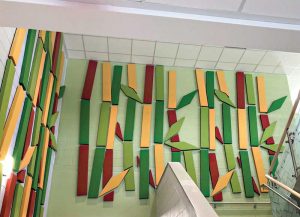
In art galleries and exhibition spaces, sound diffusion contributes to a serene and contemplative environment. By preventing sound waves from reflecting directly back to the listener, diffusers minimize acoustic distractions and create a sense of spaciousness. This enhances the visitors’ ability to focus on and appreciate the artwork without the interference of excessive noise or echoes.
Sound diffusion also finds its place in architectural designs for contemporary public buildings. By incorporating diffusive elements into the layout and decor, designers can create unique and engaging spaces. Diffusive surfaces often feature intricate geometric patterns or irregular shapes that add visual interest while enhancing acoustic comfort.
Like reflective products, diffusion solutions also offer an array of materials and creative options, from polymers to woods, along with customization. Diffusers are also great for adding forms such as pyramids, convex curves, and more that create dramatic depths and textures on a surface.
Sound diffusion is a powerful tool in acoustic design that creates balanced and immersive auditory experiences. Whether in recording studios, home theaters, art galleries, or architectural spaces, the strategic use of sound diffusion enriches the environment by reducing unwanted sound artifacts and enhancing the overall sensory perception. Architects and designers who understand the principles of sound diffusion can craft spaces that resonate with their intended purpose, elevating both form and function in their designs.
Making sound work for projects
Effective acoustic design incorporates the careful selection and placement of reflective surfaces to create acoustic environments that resonate with their intended purpose, whether it is a captivating concert, a serene worship service, or a productive business meeting.
Understanding the nuances of sound reflection empowers designers and architects to craft spaces that harmonize both form and function, providing a rich auditory experience that complements the visual aesthetics of the environment.
Whether it is absorption, reflection, or diffusion, by strategically selecting and integrating the appropriate materials for an interior environment’s intended use, architects and designers can create spaces that ultimately enhance the user experience through acoustics.



 Author
Author
